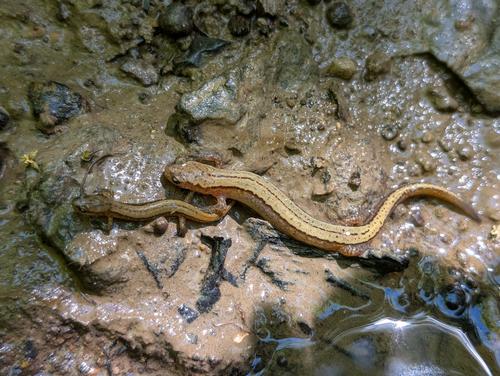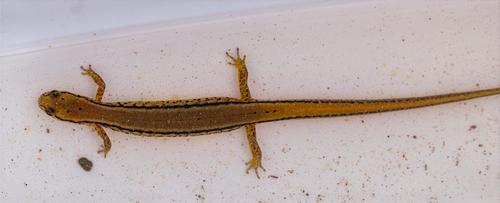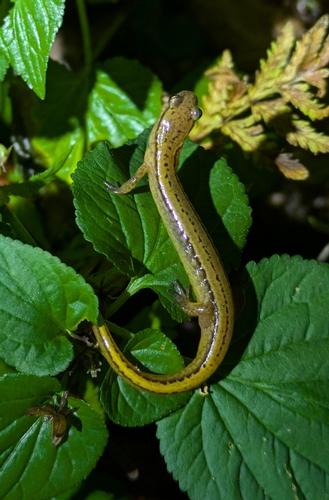Plants and Animals
Eurycea cirrigera Southern two-lined salamander
Key Characteristics
The Southern Two-lined Salamander is a small and slender salamander, with adults measuring 2.5 – 4.7 in (6 – 12 cm) in length. Their tail comprises about 50% of their total body length and is laterally flattened. Their dorsal coloration ranges from green to tan or orange, and usually contains numerous, scattered black spots or blotches. Their underbelly is yellow and unspotted. As their common name implies, two dark lines extend from behind each eye down both sides of their back, which often become blotched near the tail tip.
Status and Rank
US Status: No Status/Not Listed
State Status: SC - Special Concern (rare or uncertain; not legally protected)
Global Rank: G5 - Secure
State Rank: SNR - Not ranked
Occurrences
| County | Number of Occurrences | Year Last Observed |
|---|
Information is summarized from MNFI's database of rare species and community occurrences. Data may not reflect true distribution since much of the state has not been thoroughly surveyed.
Habitat
The Southern Two-lined Salamander inhabits temperate forests with moist environments, including streams, brooks, rivers, swamps, and spring seeps. Adults and juveniles are commonly found under logs, leaf litter, and rocks along the water’s edge. Adults also can occur under leaf litter on moist forest floors far from streams. Females lay eggs in cavities along shallow, flowing streams, attaching them to the underside of rocks or woody debris, and remain with the clutch throughout the incubation period. Larvae emerge in June or July, and remain in cool, slow-moving water with abundant natural cover, such as gravel beds, submerged logs and leaf litter, for two to three years before transforming into adults. In Michigan, this species is known to occur in and along several streams within only one site in the state, which is characterized by rolling hills and forests dominated by eastern hemlock (Tsuga canadensis).
Larvae require clear, slow-flowing water with abundant submerged natural cover. Adults need moist forest conditions and complex ground cover, such as logs and leaf litter, for shelter, protection from predators, avoiding desiccation, foraging, and egg deposition.
Natural Community Types
- Floodplain forest
- Hardwood-conifer swamp
- Mesic southern forest
- Rich conifer swamp
- Southern hardwood swamp
For each species, lists of natural communities were derived from review of the nearly 6,500 element occurrences in the MNFI database, in addition to herbarium label data for some taxa. In most cases, at least one specimen record exists for each listed natural community. For certain taxa, especially poorly collected or extirpated species of prairie and savanna habitats, natural community lists were derived from inferences from collection sites and habitat preferences in immediately adjacent states (particularly Indiana and Illinois). Natural communities are not listed for those species documented only from altered or ruderal habitats in Michigan, especially for taxa that occur in a variety of habitats outside of the state.
Natural communities are not listed in order of frequency of occurrence, but are rather derived from the full set of natural communities, organized by Ecological Group. In many cases, the general habitat descriptions should provide greater clarity and direction to the surveyor. In future versions of the Rare Species Explorer, we hope to incorporate natural community fidelity ranks for each taxon.
Management Recommendations
Management and conservation efforts should prioritize protecting suitable habitats with known populations of the Southern Two-lined Salamander. The species is sensitive to alterations in stream flow, ambient temperature, humidity, water sedimentation, and water contamination. Shaded riparian zones and entire stream watersheds should be protected and maintained. A minimum 100-ft (30-m) riparian buffer should be preserved to prevent erosion of banks and stream sedimentation. Clearcutting and other intense land use near wetlands, streams and seeps should be avoided. Selective forestry practices that include long rotations should be implemented to preserve canopy cover. Development and management practices outside the riparian buffer that could cause significant soil disturbance, alter stream hydrology, or contribute to bank erosion, water sedimentation, or water pollution should also be avoided. Additionally, maintaining riparian buffers and implementing forest management practices that retain natural ground cover, including coarse woody debris and leaf litter, will, in turn, support complex terrestrial habitat for adult salamanders. Conducting forest management activities during the winter (i.e., December to February) when the species is least active would reduce the potential for adverse impacts on adult salamanders. Preventing siltation and preserving cover in slower-moving streams will protect and support larval habitat. Additional surveys are recommended to determine if this species occurs in additional locations in the state.
Active Period
Active from first week of March to third week of November
Breeding from first week of March to fourth week of May
The species is primarily nocturnal, and individuals are most active during breeding season.
Survey Methods
Visual encounter surveys (VES) are recommended from March through June for detecting both adults and larvae of the Southern Two-lined Salamander. Adults can be located by overturning rocks and logs along stream banks or in shallow pools. Surveys for adults should be conducted during the evening and at night when individuals are most active. Larvae can be detected during daytime visual encounter surveys within slow-moving streams. Looking under rocks and other cover objects, dip-netting, and leaf litter bag sampling are effective methods for locating larvae.
Dip net survey
Survey Period: From first week of June to fourth week of July
Time of Day: Daytime
Humidity: Humid
Precipitation: Just after rain
Wind: Light Breeze
Water Level: Low Water Levels
Water Turbidity: Low Turbidity
Survey Method Comment: This method is for locating larvae in shallow pools.
Litter leaf bag sampling
Survey Period: From first week of June to fourth week of July
Time of Day: Daytime
Humidity: Humid
Precipitation: Just after rain
Wind: Light Breeze
Water Level: Low Water Levels
Water Turbidity: Low Turbidity
Survey Method Comment: Litter leaf bags are placed in shallow pools. This method is for locating larvae.
Visual encounter survey
Survey Period: From first week of March to fourth week of June
Time of Day: Evening for adults, daytime for larvae
Humidity: Humid
Precipitation: Just after rain
Wind: Light Breeze
Survey Method Comment: Both adults and larvae are most active during this time.
References
Survey References
- Crump, M.L. and N.J. Scott Jr. 1994. Visual encounter surveys. In: W.R. Heyer, M.A. Donnelly, R.W. McDiarmid, L.C. Hayek, and M.S. Foster, eds. Measuring and Monitoring Biological Diversity: Standard Methods for Amphibians. Smithsonian Institution Press, Washington, D.C. pp. 84–92.
- Giffen, N.R., R.S. Reasor, B.L. Peterson, and C.A. Campbell. 2009. Reptile and amphibian abundance and distribution survey. Oak Ridge National Environmental Research Park.
- Talley, B.L. and T.L. Crisman. 2007. Leaf litterbag sampling for larval plethodontid salamander populations in Georgia. Environmental Monitoring and Assessment.132:509-515.
Technical References
- Brenee'L, M., S.J. Price, and M.E. Dorcas. 2014. Capture probability and survivorship of the southern two-lined salamander (Eurycea cirrigera) in drought and non-drought conditions. Ichthyology & Herpetology. 2014(2), 366-37.
- Harding, J.H. and D.A. Mifsud. 2017. Amphibians and Reptiles of the Great Lakes Region. University of Michigan Press.
- Myers, P., R. Espinosa, C.S. Parr, T. Jones, G.S. Hammond, and T.A. Dewey. 2025. Eurycea cirrigera (Southern Two-lined Salamander). Animal Diversity Web. University of Michigan Museum of Zoology. Accessed July 06, 2025.
- Oswald, H. R., J.L. Waldron, S.M. Welch, S.H. Bennett, and T.A. Mousseau. 2015. Environmental effects on Southern Two-lined Salamander (Eurycea cirrigera) nest-site selection. Copeia. 103(1), 7–13.
- Peterman, W.E., and R.D. Semlitsch. 2009. Efficacy of riparian buffers in mitigating local population declines and the effects of even-aged timber harvest on larval salamanders. Forest Ecology and Management. 257(1), 8-14.
- Petranka, J.W. 1998. Salamanders of the United States and Canada. Smithsonian Institution Press, Washington, D.C. 587pp.
- Price, S.J., K.K. Cecala, R.A. Browne, and M.E. Dorcas. 2011. Effects of urbanization on occupancy of stream salamanders. Conservation Biology. 25(3), 547–555.
- Smith, S., and G.D. Grossman. 2003. Stream microhabitat use by larval southern two-lined salamanders (Eurycea cirrigera) in the Georgia piedmont. Copeia.?2003(3), 531-543.




